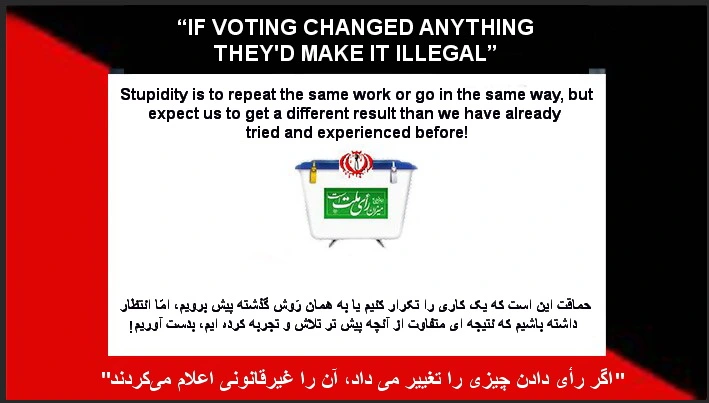Translated from Swedish:
Experience so far has shown that in the ruling Shia Islamic state of Iran, although the right to “choose” (read: appoint) all high-ranking government officials rests with the “President”, it is subject to the approval of the Islamic Parliament. But in reality, the “Welayat-e-Faqih” (Supreme Leader) must give the final approval for these appointments, and no president has been empowered to oppose the Welayat-e-Faqih’s opinion. This dynamic is not expected to change in the future.
After the overthrow of the shah’s dictatorship in 1979 and the establishment of the Shia Muslim state under Ayatollah Khomeini, most presidential elections have been heavily rigged. The candidates who emerge victorious are those who have been approved in advance by the religious leadership, first by Ruhollah Khomeini and then by Ali Khamenei.
After President Ebrahim Raisi’s helicopter crash (known as the “Ayatollah execution”) in northwestern Iran, which led to his death on May 19, 2024, a completely engineered election with predetermined candidates has been scheduled for July 28, 2024. Any individual who emerges from this electoral process, whether from the fundamentalist or reformist front, will lack the will and ability to address Iran’s deep economic, political, social and cultural crises. The hardworking people will continue to struggle against skyrocketing inflation, increasing poverty and misery, unemployment, homelessness and other issues.
Anarchist forces, who do not believe in the state, its associated bourgeois parliaments or any political parties, will not participate in such electoral systems. Instead, they focus on promoting horizontal self-organization, which operates without a party or leader. In the current situation, anarchists strive to establish a self-governing council system and promote common solidarity among the people. They strive to achieve their goals without giving up.
Welayat-e-Faqih
Can a political state and electoral system controlled by the “Welayat-e-Faqih” of the ruling Shia Islamic state of Iran be called a “republic”? Absolutely not. Islam is a monotheistic Abrahamic religion that holds the Koran as the word of Allah and Muhammad Ibn Abdullah (who lived in the Arabian Peninsula in the 6th century) as the last prophet for mankind until the resurrection.
“Welayat-e-Faqih” is a type of caliphate system in the ruling Islamic state of Iran. This doctrine is based on socio-political governance derived from the Qur’an and Islamic Sharia law. The concept of community leadership in Islam was introduced shortly after its inception and was later formulated by Sheikh Mufid (949-1022 AD), a prominent Shia Islamic theologian. Ayatollah Khomeini, a follower of Mufid, published a book called “Islamic Governance” in the 1970s during his exile in Iraq by Mohammad Reza Shah Pahlavi.
Islam claims to be the absolute and final world religion. Therefore, its followers aim to establish an Islamic state (Islamic caliphate) globally. “Califa” means successor of God’s power on earth.
After Muhammad’s death in 632 AD. a conflict over succession arose between his closest allies, leading to the division of the caliphate regime between Abu Bakr (the first caliph) and Ali (the fourth caliph). Abu Bakr’s followers became known as Sunni Muslims, while Ali’s followers became Shia Muslims. Sunni Muslims claimed that Abu Bakr was the rightful caliph, but Shia Muslims insisted that Ali was the true successor, as he was both Muhammad’s cousin and son-in-law.
Ali and his deputies were called imams (leaders). Leadership in Shia Islam is hereditary, passed down to men in Mohammad’s family. After Ali’s death, the Shia faith further divided into different branches based on which of his sons or brothers deserved to become imams. According to one group of Shia Muslims, there are twelve Imams, the last being al-Mahdi, who mysteriously disappeared at the age of five in Samarra, Iraq, in 870 AD. Believers believe that he still lives in secret and will one day appear to save the world from injustice and establish an equal society.
Ruhollah Khomeini (1909-1999) and his successor, Ali Khamenei (born 1939), belong to the group “Twelve Imami Shiites”. They claim to represent the 12th Imam, al-Mahdi. Ayatollah Khomeini and his followers have expressed a desire to export this caliphate system globally through the “Islamic Revolution”.
After the death of Ayatollah Khomeini (Welayat-e-Faqih No. 1), Ali Khamenei was chosen as his successor (Welayat-e-Faqih No. 2) by the “Islamic Parliament” and approved by the “Assembly of Leadership Experts”.
The Assembly of Leadership Experts, one of the most powerful political bodies in Iran, consists of sixty-eight members, whose competence is determined by the “Guardian Council”. The Guardian Council, which consists of twelve members (six mullahs and six lawyers), plays a decisive role in the formulation of economic and social policies and confirms the suitability of candidates for the Islamic parliament and the presidency. The Supreme Leader (Ali Khamenei) appoints all six mullahs and the head of the judiciary to the Guardian Council, and recommends the six lawyers, who must be approved by the Islamic parliament.
Given this complex system, can Iran’s socio-political structure be called a “republic” or its elections considered democratic? The logical and unequivocal answer is undoubtedly no. “Welayat-e-Faqih” is an absolute authoritarian system, comparable to regimes such as ISIS and the Taliban. It is also worth noting that no woman has ever been allowed to hold the position of religious leader or imam in the Islamic caliphate system.
– Av Hasse-Nima Golkar
deleted by creator


